Exo-Dinosaurs
Dinosaurs and rockets - two of the most appealing images for inquisitive children. Both are intimately related to the history of science, and both represent the frontiers of knowledge and a step into a world very different from that we know. Perhaps it should come as no surprise that the idea of exo-dinosaurs - dinosaurs from beyond the Earth - has a long and venerable history in speculative fiction.
Twin Planet, Twin Dinosaurs?
Some of the earliest science fiction involved planetary romances - the idea that journeys to other planets in our Solar System would reveal complex ecosystems and societies much like our own. Of our two neighbouring planets, Mars is usually represented as ancient and decaying, due to its large distance from the Sun. By contrast, Venus is shown as younger, hotter, wet and verdant. Lurking amongst the jungles of romantic Venus, more than one author found dinosaurs.
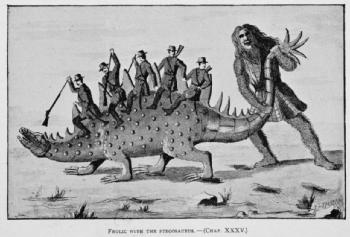 Amongst the earliest of these was Journey to Venus, published by Gustavus Pope in 1895. Pope sent his explorer, Lieutenant Frederick Hamilton, first in the other direction in Journey to Mars (1894). There he encountered an ancient race who took him on a tour of the Solar System, explaining the then-current theory that planets were thrown off from the Sun and gradually cooled and aged as they travelled outwards - hence the gradient in age from Mars through to Venus, which was home to “lower forms of life only”. In the sequel, Journey to Venus, his characters undertake a tour of the planet, encountering air, sea and land based dinosaurs, including some in captivity. The descriptions are often thorough and accurate to within the knowledge of the time, for example when encountering a stegosaurus:
Amongst the earliest of these was Journey to Venus, published by Gustavus Pope in 1895. Pope sent his explorer, Lieutenant Frederick Hamilton, first in the other direction in Journey to Mars (1894). There he encountered an ancient race who took him on a tour of the Solar System, explaining the then-current theory that planets were thrown off from the Sun and gradually cooled and aged as they travelled outwards - hence the gradient in age from Mars through to Venus, which was home to “lower forms of life only”. In the sequel, Journey to Venus, his characters undertake a tour of the planet, encountering air, sea and land based dinosaurs, including some in captivity. The descriptions are often thorough and accurate to within the knowledge of the time, for example when encountering a stegosaurus:
It resembled no animal ever seen on Earth, and was nearly forty feet long. Its huge, bulky body was covered with. a thick, horny shell, studded over with large black knobs. But the most remarkable feature was a row of a dozen or more triangular bony plates, nearly three feet high; set edgewise with their points upward, all along its back from head to tail. They resembled the teeth of a gigantic saw. Its long thick tail was armed with a row of horny spikes, standing up like sword-blades, which, together with the thick shell, afforded ample defence against the assaults of enemies, as well as an efficient weapon of attack. Its head and neck resembled the lizard; its legs were armed with strong claws; His arched back rose like a dome, eight feet from the ground. - pg 361.
However despite this fearsome description, the explorer and his companions are soon calling the creature Steggy and even riding on her back!
Pope clearly attempted to incorporate current scientific opinion regarding the evolution and life of dinosaurs into his work, including in dialogue between his characters, and in footnotes which pointed readers towards the literature, museum examples or further information. However while Pope’s explorers encountered exact parallels to early Earth life including megalosaurus, dinoceras and triceratops, they also encountered sabre tooth cats, megatheriums, mammoths and early hominids, which on Earth were separated by 65 million years from the saurians and evolved in very different environmental conditions. This compression of time, as well as the demands of plot, makes for rather a confused picture.
The idea of an environment much like the Carboniferous forests of Earth’s own prehistory - and that familiar dinosaurs could be found there - lasted a surprisingly long time in science fiction, not really becoming displaced until probe landers revealed the true surface conditions in the late 1960s. Even then, it lingered both in children’s fiction, and in stories written by authors raised on such ideas.
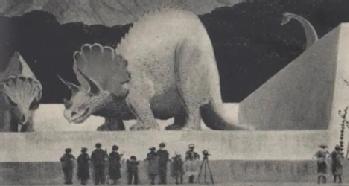 In 1950, Coronet magazine in the United States published a short story called “Mr Smith goes to Venus” in which the titular character and his family find both Venusians and dinosaurs. Around the same time, in the UK, Captain W E Johns, best known for his Biggles novels, sent an eccentric professor, his butler, a flying ace who came knocking on his door while lost, and the pilot’s son on a journey around the Solar System (and beyond) in his Kings of Space series (novels, starting in 1954). It's interesting to note that these were intended to be educational and based on then-current knowledge (although that remit faded rapidly after the first book in the series). The very first of these took his explorers to Venus where - like Pope’s explorer - they found thick jungle, brontosaurus, megalosaurus and pterodactyl, and even more startlingly, early hominids. While this pleases the explorers, it does not appear to surprise them:
In 1950, Coronet magazine in the United States published a short story called “Mr Smith goes to Venus” in which the titular character and his family find both Venusians and dinosaurs. Around the same time, in the UK, Captain W E Johns, best known for his Biggles novels, sent an eccentric professor, his butler, a flying ace who came knocking on his door while lost, and the pilot’s son on a journey around the Solar System (and beyond) in his Kings of Space series (novels, starting in 1954). It's interesting to note that these were intended to be educational and based on then-current knowledge (although that remit faded rapidly after the first book in the series). The very first of these took his explorers to Venus where - like Pope’s explorer - they found thick jungle, brontosaurus, megalosaurus and pterodactyl, and even more startlingly, early hominids. While this pleases the explorers, it does not appear to surprise them:
"A dinosaur! A living dinosaur, by all that's marvellous!" declared the Professor in a high-pitched voice that revealed his excitement. "Isn't he magnificent? Herds of them once wallowed where London now stands, for they have left their teeth and bones in the clay to prove it. There were several sorts, some vegetable eaters and some carnivorous. My friends, Regent Street was once such a track as you see below. It was the path the monsters made to reach the Thames, and primeval man could only move along the same trail. It's a far cry from those original tracks to tar macadam. I fancy the fellow below is Brontosaurus excelsus - a vegetarian" (pg 124, Piccolo 1980 edition)
A very similar experience met comic book character The Green Lantern in “Summons from Space!” (DC comics, 1959), and also the children who accompanied their scientist father (and a friendly journalist) into space by rocket in the television series Pathfinders to Venus (1961). Again, not only is the life on this Venus also a perfect duplicate of Earth species, but its foetid jungles host both dinosaurs and prehistoric humans. In Pathfinders, the characters’ main driver is to locate a crashed American astronaut and return safely to Earth, but the prehistoric life provides a threat to drive the plot and harks back to the earlier understanding - even though remote observations by scientists were already challenging this picture of our sister planet. Other examples abound, including the Soviet film Planeta Bur (Planet of Storms, 1962, dir. Klushantsev), footage from which was adapted in English as two different B movies - Voyage to the Prehistoric Planet (1965) and Voyage to the Planet of Prehistoric Women (1968).
After the Venera probe descended through Venus’s clouds in 1966 to find an inferno, such stories finally lost traction, although this doesn’t lessen the attraction of affectionate pastiches like S M Stirling’s novel The Sky People (2006), set in a parallel universe where the Space Race really did lead to the discovery of civilisations on Mars and Venus, and Venusian dinosaurs really do threaten settlers from Earth.
Distant Origins
If we can’t find familiar dinosaurs on Venus, then perhaps the next best thing would be to find surviving dinosaurs from Earth’s prehistory - but surviving in space.
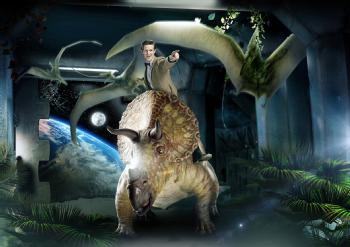 The 2012 episode of television series Doctor Who “Dinosaurs on a Spaceship” had exactly this premise. Since the 1970s, the Doctor Who universe has included the Silurians (aka Earth Reptiles or Homo reptilia), an technologically-advanced form of intelligent anthropoid saurian who once inhabited the Earth. An impending disaster led this entire race to seek shelter in underground hibernation centres, but the automated system to reawaken them failed and very few of the Silurian hibernation centres survive with their suspended occupants. In “Dinosaurs on a Spaceship” this premise is extended with the discovery of a Silurian ark - a spaceship designed to preserve some of Earth’s then-contemporary wildlife from the coming disaster. The episode delivers pretty much exactly what its title promises, with triceratops, pteranodons and tyrannosaurs aboard the vessel, which is on an unfortunate collision course with Earth when it is discovered.
The 2012 episode of television series Doctor Who “Dinosaurs on a Spaceship” had exactly this premise. Since the 1970s, the Doctor Who universe has included the Silurians (aka Earth Reptiles or Homo reptilia), an technologically-advanced form of intelligent anthropoid saurian who once inhabited the Earth. An impending disaster led this entire race to seek shelter in underground hibernation centres, but the automated system to reawaken them failed and very few of the Silurian hibernation centres survive with their suspended occupants. In “Dinosaurs on a Spaceship” this premise is extended with the discovery of a Silurian ark - a spaceship designed to preserve some of Earth’s then-contemporary wildlife from the coming disaster. The episode delivers pretty much exactly what its title promises, with triceratops, pteranodons and tyrannosaurs aboard the vessel, which is on an unfortunate collision course with Earth when it is discovered.
While the dinosaurs in the Silurian Ark have been in stasis and take their familiar forms, other narratives have explored the evolved descendants of Earth dinosaurs. The Star Trek: Voyager television episode “Distant Origin”, for example, centres on a saurian race called the Voth which believes itself to be ancient and local to the Delta quadrant (distant from Earth). A maverick molecular paleontologist supports the unpopular Distant Origin theory, and is charged by the authorities of his species with “heresy against doctrine”. When he finds evidence of genetic matches to human remains, he tracks down the starship Voyager as evidence. Analysis by Voyager’s computer confirms that his species are descended from Earth’s hadrosaur dinosaurs and hypothesises that they evolved into intelligence on an isolated continent of Earth before the impact of the Chixalub asteroid. The Voth descend from survivors who escaped into space before that event, with all evidence of their existence destroyed since by erosion, plate tectonics or ice-sheet advances. However the doctrinal authorities of the saurian race capture both the scientist and Voyager in an attempt to suppress the challenge to their authority.
In the Quintaglio Ascension Trilogy (Far-Seer, 1992; Fossil Hunter, 1993; Foreigner, 1994) written by Robert J Sawyer, therapod dinosaurs (i.e. tyrannosaurs) were transplanted from Earth by a benevolent alien race before the mass extinction, and have since evolved intelligence. The novels are an allegory of enlightenment humanity, with the saurian Quintaglios in the process of a scientific revolution and new ideas coming into conflict with religious doctrine (as was also the case in the Voyager episode discussed above). By contrast, Anne McCaffrey’s Dinosaur Planet novels focus on the mystery of Ireta, a planet which is discovered to host extinct species from a wide range of different biological evolutions (i.e. different planets) including many dinosaurs such as stegosaurs, pteranodons, tyrannosaurs, hadrosaurs and primitive mammals such as the horse-ancester hyracotherium from Earth. As might be expected, these come as a surprise, despite the fact that they have adapted to their new environment:
"Fang-face, and herbivores and the golden fliers? Oh Trizein, it isn't possible. Besides the difference in pigmentation indicates that they evolved here..."
"Oh yes, but they started on Earth. I don't consider camouflage or pigmentation a real deterrent to my theory. All you'd need is one common ancestor. Climate, food, terrain would all bring about specialization over the millenniums and the variety of types would evolve" (pg 152, Orbit 1984 edition)
Ireta has clearly been engineered but its origins remains a mystery to the party of explorers trying at first to survey the planet, and later simply to survive.
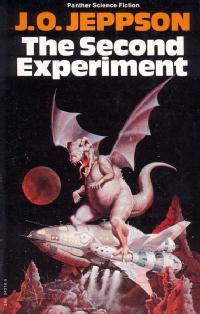 The novel The Second Experiment (Jeppson, 1974) is notable for having a winged, alien tyrannosaur riding a rocket on the cover. The descent of this particular dinosaur is complex. The Roiiss are an ancient race who came from a long-lost home planet. Their sole descendant, a dragon-like individual called R’ya, is raised by a robot servitor, visits ancient Earth and adopts a tyrannosaurus rex who resembles herself and which she calls Uru. From him she breeds a race of intelligent, winged tyrannosaurs, but when their descendants return to Earth they find that the dinosaurs have been wiped out by a nearby supernova. Placed in suspended animation, R’ya and the robot rewaken on modern Earth, before again travelling through time and space.
The novel The Second Experiment (Jeppson, 1974) is notable for having a winged, alien tyrannosaur riding a rocket on the cover. The descent of this particular dinosaur is complex. The Roiiss are an ancient race who came from a long-lost home planet. Their sole descendant, a dragon-like individual called R’ya, is raised by a robot servitor, visits ancient Earth and adopts a tyrannosaurus rex who resembles herself and which she calls Uru. From him she breeds a race of intelligent, winged tyrannosaurs, but when their descendants return to Earth they find that the dinosaurs have been wiped out by a nearby supernova. Placed in suspended animation, R’ya and the robot rewaken on modern Earth, before again travelling through time and space.
The premise of descended Earth dinosaurs achieving intelligence also informs The Bowl of Heaven and Shipstar by Larry Niven and Gregory Benford. These novels feature an apparently alien race that proves to have an origin closer to home. Here a human colony ship en route to a distant planet called Glory encounter a partial Dyson sphere - a megastructure shaped like a bowl cupping its sun, and with a surface area millions of times that of Earth. The dominant species on the Bowl are the Folk, who appear to be large but bird-like. As gradually becomes clear, these didn’t descend from modern avians, but rather from the feathered dinosaurs, collected from Earth in the distant past [1].
The connection between avians and their dinosaur progenitors is also explored, but to more comedic effect, in the science fiction situation comedy Red Dwarf. In the two-part episode “Pete” (1999), a prisoner’s pet sparrow is exposed to a “time wand”. This causes the tiny bird to devolve into a massive tyrannosaur that goes on a rampage through the mining ship Red Dwarf. This particular dinosaur on a spaceship might not make a lot of sense (or even make for a particularly good episode) but shows the attraction of mixing the ancient with the futuristic. Similarly not-entirely-serious approaches to achieving this mixture can be found in the animated series Dinosaucers (1987, which presumes dinosaurs surviving on a twin planet to Earth) and Dinosaurs in Space (2020, where dinosaurs are urged to build a spaceship by a time traveller) and in the Astrosaurs series of children's books by Steve Cole (2005 onwards, in which many species of dinosaur migrated away from Earth before the asteroid impact).
Compelling Convergence
Both earth-twin Venusian dinosaurs and resettled Earth saurians require some significant suspension of disbelief. However science fiction has also explored the possibility of true exo-dinosaurs: saurian aliens who evolved to resemble the dinosaurs of Earth as a result of a similar evolutionary response to similar environmental conditions and pressures.
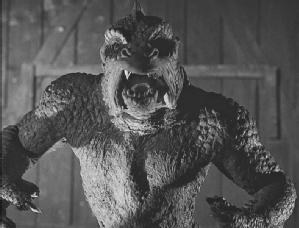 An example here is the science fiction monster movie 20 Million Miles to Earth (1957, dir. Juran). A crashed spacecraft, just returned from Venus, carries an egg. The creature that hatches, stop-motion animated by Ray Harryhausen, is not a recognisable or identifiable dinosaur species but is nonetheless clearly saurian and inspired by the dinosaurs of Venus that inhabited the popular imagination at the time. The Venus concerned was still a jungle world, capable of being visited by humans. Nonetheless, the film notably avoids the fallacy of an exact dinosaur reproduction (and of including ancient hominids!).
An example here is the science fiction monster movie 20 Million Miles to Earth (1957, dir. Juran). A crashed spacecraft, just returned from Venus, carries an egg. The creature that hatches, stop-motion animated by Ray Harryhausen, is not a recognisable or identifiable dinosaur species but is nonetheless clearly saurian and inspired by the dinosaurs of Venus that inhabited the popular imagination at the time. The Venus concerned was still a jungle world, capable of being visited by humans. Nonetheless, the film notably avoids the fallacy of an exact dinosaur reproduction (and of including ancient hominids!).
Similar dinosaurian but independently evolved intelligent aliens feature in in James White’s Sector General short story "Trouble with Emily" (1958), and in examples of reptilian aliens in many science fiction franchises, such as the Gorn in Star Trek (“Arena”, 1967; also the separate race of Saurians responsible for Saurian brandy).
While in some cases the evolutionary convergence passes without comment, in others, the parallels drive the plot. The novel Lords of Creation by Tim Sullivan (1992), for instance, features saurian aliens from Epsilon Eridani who tried to save Earth’s dinosaurs through bioengineering them for higher intelligence. The experiment fails, but when the dinosaurs were wiped out, five eggs remained in a stasis box. These hatch when excavated by palaeontologists working in a religiously-fundamentalist future America, and soon a dinosaur-like Eridanian caretaker turns up to rescue them (if he can) from the threat of authorities determined to establish their own religiously-motivated view of Earth’s past.
Other science fiction sets aside the idea of intelligence, but retain the vivid imagery of dinosaur-like aliens, such as the Banshees and Leonopteryx of the Avatar (2009) universe (although these admittedly also owe something to the overlapping mythology of dragons). Of course, some narratives perhaps take this parallel evolution too far - as is the case in (the rather-amusingly bad) film Planet of Dinosaurs (1977). Here the exo-dinosaurs encountered by shipwrecked human explorers are not transplanted from Earth, and are on a remote planet rather than Venus, but nonetheless are exact replicas of identifiable Earth species, including the inevitable tyrannosaurs. Of course, such perfect convergence is as unlikely on an alien planet as on Venus.
The Poster Children of Evolution
So what gives dinosaurs such a wow factor that we wish to populate even the depths of space with their progeny?
There is a sense in which the detailed understanding of dinosaurs, like those of space itself, is the province of experts - scientists and intricate scientific analysis. They become poster children for science, and a focus for the type of child who craves information, detail and complexity. More than that, they become poster children for one of the basic tenets of biological sciences - evolution - in the same way that rockets become the poster children for physical sciences. The way dinosaur bones are associated with deep time (timescales long enough for both fossilisation and evolution to take place), and the way that gradual changes to species can be inferred from their forms, made them some of the earliest and most striking evidence invoked by evolutionary theorists. This makes them prime material for fiction that builds on scientific understanding and extrapolation. However it also makes them key material for any writer who wishes to explore the interplay between scientific understanding and religious beliefs. By being a poster child for evolution, dinosaurs also become a symbol of the ascent of scientific reasoning and the subsequent challenges to, and diminution of, the power of religious authority. Thus stories such as Sullivan’s Lords of Creation in which a government Department for Morality explicitly opposes palaeontology. Thus also the ironic resonance of Star Trek: Voyager’s “Distant Origins” in which a dinosaur descendent himself becomes the one challenging established doctrine. These stories are as much about the way society sees science and values scientific versus traditional knowledge as about the dinosaurs at their focus.
However, perhaps first and foremost, there is an intrinsic fascination in knowing that such a variety of complex life existed on Earth and has gone - particularly in the form of carnivores that would make our own existence implausible. The idea that the existence of such well developed life could be fragile makes us question our own future. And the idea that the world existed happily before humanity evolved, and could even have gone in a very different way, challenges our own traditional positioning as the focus of creation. The manner of the dinosaur’s extinction, mysterious for so long and later ascribed to such a dramatic event as an asteroid impact, simply adds to that fascination. And, of course, dinosaurs - like rockets - are big and loud and ferocious… and (when seen from a distance) simply good fun. No wonder then that Bill Watterson’s long-running Calvin and Hobbs comic strip series featured dinosaurs in space as a recurrent theme in the vivid imagination of its young protagonist.
While only a small group of humans have ever travelled into space, it should perhaps come as no surprise that dinosaurs have also been there - in both the real world and in fiction. The juxtaposition of the old and the new, the biological sciences and the physical, the future and the deep past makes for compelling fiction and imagery which will no doubt continue to do so in the years ahead.
“Exo-dinosaurs”, Elizabeth Stanway, Cosmic Stories blog. 10th September 2023
Notes:
[1] Bowl of Heaven and Shipstar are also notable for hypothesising that the red dwarf star at the centre of the travelling Dyson sphere was one a distant companion of the Sun. About a fifth of sun-like stars have a binary companion, and it’s long been wondered whether the Sun might have, or have had, a companion. So far there is no evidence that such a star ever existed - let alone that it was co-opted in a mega-engineering project. [Return to Text]
Further reading:
I came across a couple of interesting articles on other blogs while researching this entry. I’d encourage you to take a look at this one in the Smithsonian magazine, and this one in Vice. It says something for the popularity of this topic that so many others have written about it!
The views and opinions expressed here are those of the author and do not necessarily reflect those of the University of Warwick. All images sourced from publicly-accessible sources online.
